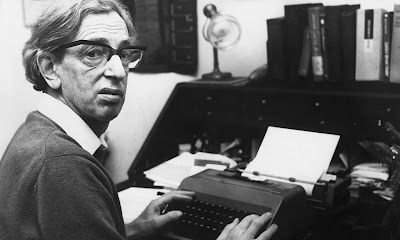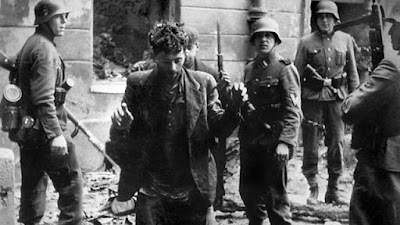photo: Hobsbawm at work
The British historian Eric Hobsbawm was a leading member of the British Communist Party-affiliated Historians' Group. This was a group of leading British historians who were members of the British Communist Party in the 1940s. In 1978 Hobsbawm wrote a historical memoir of the group recalling the important post-war decade of 1946-1956, and Verso Press has now republished the essay online (link). The essay is worth reading attentively, since some of the most insightful British historians of the generation were represented in this group.
The primary interest of Hobsbawm's memoir, for me anyway, is the deep paradox it seems to reveal. The Communist Party was not well known for its toleration of independent thinking and criticism. Political officials in the USSR, in Comintern, and in the European national Communist parties were committed to maintaining the party line on ideology and history. The Historians' Group and its members were directly affiliated with the CPGB. And yet some of Britain's most important social historians were members of the Historians' Group. Especially notable were Eric Hobsbawm, Christopher Hill, Edward and Dorothy Thompson, Maurice Dobb, Raphael Samuel, Rodney Hilton, Max Morris, J. B. Jefferys, and Edmund Dell. (A number of these historians broke with the CPGB after 1956.) Almost all of these individuals are serious and respected historians in the first rank of twentieth-century social history, including especially Hobsbawm, Hill, E.P. Thompson, Dobb, and Hilton. So the question arises: to what extent did the dogmatism and party discipline associated with the Communist Party since its origins influence or constrain the historical research of these historians? How could the conduct of independent, truthful history survive in the context of a "party line" maintained with rigorous discipline by party hacks? How, if at all, did British Marxist historians escape the fate of Lysenko?
The paradox is clearly visible in Hobsbawm's memoir. Hobsbawm is insistent that the CP members of the Historians' Group were loyal and committed communists: "We were as loyal, active and committed a group of Communists as any, if only because we felt that Marxism implied membership of the Party." And yet he is equally insistent that he and his colleagues maintained their independence and commitment to truthful historical inquiry when it came to their professional work:
Second, there was no 'party line' on most of British history, and what there was in the USSR was largely unknown to us, except for the complex discussions on 'merchant capital' which accompanied the criticism of M. N. Pokrovsky there. Thus we were hardly aware that the 'Asiatic Mode of Production' had been actively discouraged in the USSR since the early 1930s, though we noted its absence from Stalin's Short History. Such accepted interpretations as existed came mainly from ourselves— Hill's 1940 essay, Dobb's Studies, etc.—and were therefore much more open to free debate than if they had carried the by-line of Stalin or Zhdanov....
This is not to imply that these historians pursued their research in a fundamentally disinterested or politically neutral way. Rather, they shared a broad commitment to a progressive and labor-oriented perspective on British history. And these were the commitments of a (lower-case) marxist interpretation of social history that was not subordinate to the ideological dictates of the CP:
Third, the major task we and the Party set ourselves was to criticise non-Marxist history and its reactionary implications, where possible contrasting it with older, politically more radical interpretations. This widened rather than narrowed our horizons. Both we and the Party saw ourselves not as a sect of true believers, holding up the light amid the surrounding darkness, but ideally as leaders of a broad progressive movement such as we had experienced in the 1930s.... Therefore, communist historians—in this instance deliberately not acting as a Party group—consistently attempted to build bridges between Marxists and non-Marxists with whom they shared some common interests and sympathies.
So Hobsbawm believed that it was indeed possible to be both Communist as well as independent-minded and original. He writes of Dobb's research: "Dobb's Studies which gave us our framework, were novel precisely because they did not just restate or reconstruct the views of 'the Marxist classics', but because they embodied the findings of post-Marx economic history in a Marxist analysis." And: "A third advantage of our Marxism—we owe it largely to Hill and to the very marked interest of several of our members, not least A. L. Morton himself, in literature—was never to reduce history to a simple economic or 'class interest' determinism, or to devalue politics and ideology." These points are offered to support the idea that the historical research of the historians of this group was not dogmatic or Party-dictated. And Hobsbawm suggests that this underlying independence of mind led to a willingness to sharply criticize the Party and its leaders after the debacle of 1956 in Hungary.
But pointed questions are called for. How did historians in this group react to credible reports of a deliberate Stalinist campaign of starvation during collectivization in Ukraine in 1932-33, the Holodomor? Malcolm Muggeridge, a left journalist with a wide reputation, had reported on this atrocity in the Guardian in 1933 (link). And what about Stalin's Terror in 1936-1938, resulting in mass executions, torture, and the Gulag for "traitors and enemies of the state"? How did these British historians react to these reports? And what about the 1937 show trials and executions of Bukharin, Zinoviev, Kamenev, and Rykov, along with hundreds of thousands of other innocent persons? These facts too were available to interested readers outside the USSR; the Moscow trials are the subject of Arthur Koestler's Darkness at Noon, published in 1941. Did the historians of the Historians' Group simply close their eyes to these travesties? And where does historical integrity go when one closes his eyes?
Arthur Koestler, George Orwell, and many ex-communist intellectuals have expressed the impossible contradictions contained in the idea of "a committed Communist pursuing an independent and truth-committed inquiry" (link, link, link). One commitment or the other must yield. And eventually E. P. Thompson came to recognize the same point; in 1956 he wrote a denunciation of the leadership of the British Communist Party (link), and he left the Communist Party in the same year following the Soviet suppression of the Hungarian uprising.
Hobsbawm's own career shows that Hobsbawm himself did not confront honestly the horrific realities of Stalinist Communism, or the dictatorships of the satellite countries. David Herman raises the question of Hobsbawm's reactions to events like those mentioned here in his review of Richard Evans, Eric Hobsbawm: A Life in History and Eric Hobsbawm, Interesting Times: A Twentieth-Century Life (link). The picture Herman paints is appalling. Here is a summary assessment directly relevant to my interest here:
However, the notable areas of silence -- about Jewishness and the crimes of Communism especially -- are, ultimately, devastating. Can you trust a history of modern Europe which is seriously misleading about the French and Russian Revolutions, which barely touches on the Gulag, the Holocaust and the Cultural Revolution, which has so little to say about women and peasants, religion and nationalism, America and Africa?
And what, finally, can we say about Hobsbawm's view of Soviet Communism? In a review called "The piety and provincialism of Eric Hobsbawm", the political philosopher, John Gray, wrote that Hobsbawm's writings on the 20th century are "highly evasive. A vast silence surrounds the realities of communism." Tony Judt wrote that, "Hobsbawm is the most naturally gifted historian of our time; but rested and untroubled, he has somehow slept through the terror and shame of the age." Thanks to Richard Evans's labours it is hard to dispute these judgments. (199-200)
Surely these silences are the mark of an apologist for the crimes of Stalinism -- including, as Herman mentions, the crimes of deadly anti-semitism in the workers' paradise. Contrary to Hobsbawm, there was indeed a party line on the most fundamental issues: the Party's behavior was to be defended at all costs and at all times. The Terror, the Gulag, the Doctors' Plot -- all were to be ignored.
Koestler's protagonist Rubashov in Darkness at Noon reflects on the reasons why the old Bolsheviks would have made the absurd confessions they offered during the Moscow show trials of the 1930s:
The best of them kept silent in order to do a last service to the Party, by letting themselves be sacrificed as scapegoats -- and, besides, even the best had each an Arlova on his conscience. They were too deeply entangled in their own past, caught in the web they had spun themselves, according to the laws of their own twisted ethics and twisted logic; they were all guilty, although not of those deeds of which they accused themselves. There was no way back for them. Their exit from the stage happened strictly according to the rules of their strange game. The public expected no swan-songs of them. They had to act according to the text-book, and their part was the howling of wolves in the night....
This is the subordination of self to party that was demanded by the Communist Party; and it is still hard to see how a committed member of the Communist Party in the 1930s, 1940s, and 1950s could escape the logic of his or her commitment. Personal integrity as an intellectual was not part of the bargain. So the puzzle remains: how could a Hobsbawm or Thompson profess both intellectual independence and commitment to the truth in the histories they write, while also accepting a commitment to do whatever is judged necessary by Party officials to further the cause of the Revolution?
Regrettably, there is a clear history in the twentieth century of intellectuals choosing political ideology over intellectual honesty. Recall Sartre's explanation of his silence about the Gulag and the Soviet Communist Party, quoted in Anne Applebaum's Gulag:
“As we were not members of the Party,” he once wrote, “it was not our duty to write about Soviet labor camps; we were free to remain aloof from the quarrels over the nature of the system, provided no events of sociological significance occurred.” On another occasion, he told Albert Camus that “Like you, I find these camps intolerable, but I find equally intolerable the use made of them every day in the bourgeois press.” (18)
So much better is the independence of mind demonstrated by an Orwell, a Koestler, a Camus, or a Muggeridge in their willingness to recognize clearly the atrocious realities of Stalinism.
(Here is an earlier post on the journal created by the Historians' Group,
Past & Present;
link. And here are several earlier posts about post-war Marxist historians;
link,
link,
link.)










